The Sava levee, which protects the municipality Novi Beograd from high waters, has been endangered for a long time by various illegal and extremely dangerous activities (and completely undisturbed by the competent authorities): A. Damage to the levee by illegal excavation of trenches for installation setup, B. Endangerment of levee by traffic abuse, C. Endangerment of flood protection by building illegal transverse levees in the Sava’s river bed for high waters. The position on all three problems is summarized below.
A. Damage to the Levee by Illegal Excavation of Trenches for Installation Setup
1. Flood protection levees are only seemingly simple objects, but they are extremely sensitive structures, which is the reason why their integrity must not be endangered in any way. This is especially true for those levees that can be under the backwater of high waters for a long time, which is the case with the Sava levee. Due to the long duration of the high waters of the Danube, this levee was under high backwater for more than two months in 1965, and it was very seriously endangered several more times, including the most dangerous time during May-June 2014.
Protective levees are built by filling and compacting thin layers of carefully selected material, in order to ensure the complete compactness of the soil structure. In hydraulic engineering, there is a rule: no pipes may be pulled through the hull of the filled structure, which can be under long-term backwater (that is – under water). And even if they are pulled because they are necessary somewhere (only for flood protection and drainage system infrastructure), then a special protective diaphragm must be made, in order to prevent the water seepage along the pipe walls and progressive suffusion (flushing small, and then over time larger particles), which will eventually lead to the collapse of the filled structure in that zone. Therefore, it is clear that any excavation of the transverse trench over the levee, which is later filled superficially, without compaction, is extremely dangerous damage.
In order to notice the great danger of such activities, it should be noted that there are numerous causes of levee damage, as shown in Picture 1. Particularly dangerous is the situation when water finds its way through the damage in the levee hull and begins the process of suffusion, which is manifested by the appearance of sources of muddy water on the slope of the levee or at its foothill on the defended side, which is the first warning that the levee is very endangered. Damage inside the levee is progressively spreading, cavities are forming, larger and larger fractions of material are being washed away, water seepage is accelerating and finally there is a sudden collapse – the collapse of the levee. The water from the river breaches the protected area at high speed, endangering the population and material goods. The photos in Picture 2 show that the Sava levee is really endangered by the scenario described above.
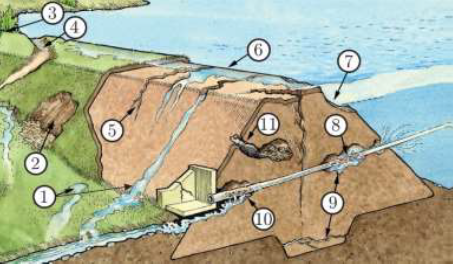
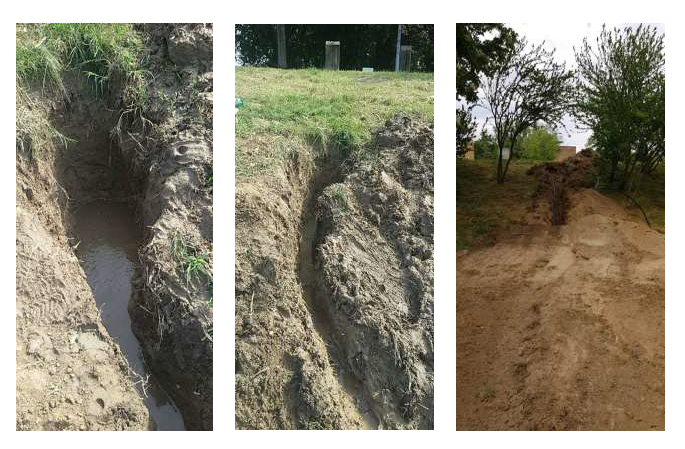
The methods used by illegal builders, damaging the levee are also shown in the photos in Picture 3. You can see trenches that become places where it can be expected that the levee will be weakened very quickly and it will be breached, in the conditions of high waters of the Sava River. Some of the damage is so severe that it is estimated that the collapse of the levee could take only a few hours. Illegal builders often dig a trench to a place on the slope of the levee, and then drill the levee with drills in order to pull through the installation. A horizontal hole remains in the body of the levee through which water begins to breach, immediately after the formation of the backwater on the Sava River due to the high level of the Danube. The supply pipes that are pulled through the levee often burst, and water from the mentioned pipes flows uncontrollably into the hull of the levee for a long time and completely soaks it, thus destroying the structure in the long run. After a while, the illegal owners bring new diggers, dig a new trench, replace the pipe, and again temporarily fill the trench, and sometimes they do not even do that. It seems frightening to any civil engineer that the water is found in the levee construction, already after small depth of excavation and even in dry weather, when the levee is not under a high level of river (Picture 3). The water obviously got there from damaged water pipes or hoses pulled through the levee body.
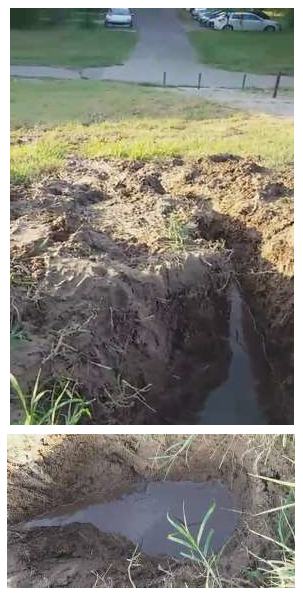
Repair of the levee at the damaging places implies radical intervention – removal of the entire part of the levee and its rebuilding, layer by layer, with compaction, using the same principles for building a new levee.
2. It is obvious that the described condition is very dangerous and – unsustainable. All damages need to be repaired. The following answers are given to the questions addressed to Department of Civil Engineering.
(a) Who is in charge? The current and investment maintenance of the levee is in the exclusive competence and responsibility of the Public Water Management Company Srbijavode, VC Sava-Dunav. The competent authorities should perform a detailed inspection of the levee, determine how the installations were installed to the specific rafts, and to review all locations where the levee was damaged and where repairs are necessary. It would be desirable that activists of the Association of Citizens ‘Savski nasip’ assist in this search, activists who monitored, recorded and (in vain) reported these illegal activities.
(b) Method of repair. The problem of levee damage is so serious that the repair of all damaged places must be done without improvisations, using the same principles for building a new levee, in order to achieve a reliable monolithic of the construction. The extent of the intervention depends on the depth and width of the damage.
A standard project should be done first, based on the following principles:
- The damaged levee layer should be removed all the way to the undamaged part (layer), on which the repair could be based by filling in layers and compaction, in the same way as it is done during the construction of a new levee (with compaction controls, etc.).
- All water pipes previously installed through the levee in order to supply rafts should be removed, and possibly other facilities such as illegal cottages.
- Where the levee damage is quite narrow, the minimum width of the part that is removed, replaced with appropriate material and compacted is conditioned by the size of the vibrating machine which will be used for compaction in layers.
- In places where the levee damage is severe due to the long soaking of the levee body, the entire damaged zone should be removed, and this should be determined and approved by a licensed geotechnical expert, with experience in levee construction.
- During repair, the control of works should be performed according to the same procedure as the control of works for construction of new levees, which includes compaction tests.
- Repair works should be performed taking into account that no insufficiently compacted part remains on the joints of the original and new construction of the levee, where the compaction machine has not reached. This can be achieved with a trapezoidal excavation of the trench in which the repair will be performed, so that when compacting the upper layer, it partially overlaps with the lower, already compacted layer.
3. Scope of works. At the moment, it is not possible to estimate the scope of work, because even the basic data is not known for now: how many damaged places there are. Therefore, right now it is not possible to give a preliminary cost estimate. There are competent experts for this job, but all these activities are in the hands of the Public Water Management Company Srbijavode and these activities must be performed in accordance with a clearly defined legal procedure, because in this case it is about investment maintenance of the object, which the state entrusted to Srbijavode.
4. Phases. The phases of works depends on the number of damaged places that need to be repaired, which are not known right now. Priority in the realization should be given to those places that are most severely damaged (parts of the levee that have been exposed to water leaks from pipes for a long time). Works should be performed in the dry part of the year, when such activities can be reliably and efficiently implemented.
5. System solution for water supply of rafts. The problem of water supply of rafts must be solved systematically. The city would finally have to bring order to the installation of rafts and their servicing. The number and position of rafts must be in accordance with the appropriate adopted plan. Rafts should not be supplied with water (as usual) individually, by pulling the water supply installations through the levees. This should be solved by installing a water supply pipe along the shore, so that only those rafts that have received permits are connected to it, according to stricter criteria than those used right now. The existing levee must not be drilled in order to pull through the water supply pipe.
6. The problem of raft sanitation. As for wastewater evacuation, rafts are now the “black spots” of Belgrade. All wastewaters flow into the river and that is an unsustainable condition. A special problem are the rafts in the immediate vicinity of the water intake on the Sava and near the Renny well. In the low-water parts of the year, this sanitary-ecological problem culminates. There are several ways to solve this problem, but it is beyond the scope of this analysis. However, it is certain that the current situation regarding wastewater release is unsustainable.
B. Endangerment of Levee by Traffic Abuse
The topic of this review is illegal holiday homes (more than 300 of them), which were built on water land and in the protection zone of the Belgrade Waterworks spring (Picture 4). Mentioned activities grossly violated the provisions on water land in the Spatial Plan of the Republic of Serbia and the Law on Waters, as well as the provisions of the Rulebook on the Manner of Determining and Maintaining Sanitary Protection Zones of Springs (Official Gazette 92/08).
The construction of illegal facilities on water land is an unprecedented activity, which damages the reputation and authority of the state in terms of the rule of law, protection and maintenance of vital infrastructure systems (flood protection and water supply).
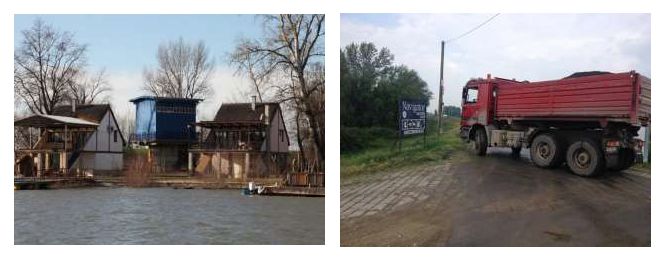
There is also a very important security issue. The owners of illegally built facilities are abusing the Sava levee in order to access their houses. The levee (dimensioned exclusively as a protective object) is abused not only by passenger cars, but also by heavy vehicles, which deliver material to the construction sites of new houses. Namely, the state did not submit decisions to the owners of illegally built houses stating that their application for legalization was rejected and did not give them any reasonable deadline for the removal of those facilities. This has encouraged new intruders who are hastily building more and more new facilities, so that heavy trucks (Picture 4), concrete mixers, multi-axle transporters carrying excavators, bulldozers, and even rollers for rolling illegally built access roads towards the houses on the coast move along the levee. The destruction of the levee by traffic is in full swing.
The mentioned abuse of the Sava levee is very dangerous because it endangers the entire part of the municipality Novi Beograd, which is at a lower level than the level of high waters of the Sava River. These flood levels, depending on the cause (one of the most dangerous cause is the coincidence of high levels of the Danube and Sava), can last several months, which puts the protective systems to the test in terms of endurance of levee construction. According to valid planning documents, line protection systems – levees and accompanying drainage systems for protection against inland high waters – Belgrade must defend itself from five hundred years of high waters (with mobile systems even from a thousand years of high waters), and the destruction of the Sava levee by traffic must be considered through that prism. In the flood protection system of the municipality Novi Beograd, the Sava levee is a key element.
The traffic on the levee and the dynamic loads it causes are very seriously endangering the levee. This adverse effect takes place in several directions, and the following two are particularly serious:
(a) Кoncentrisana opterećenja praćena vibracijama, aktiviraju klizne površine na kosinama nasipa, čime se narušava stabilnost objekta. Na nekim mestima se već uočavaju pukotine koje daju indikaciju da je došlo do školjkastih oštećenja kosina nasipa. To je veoma opasna pojava, čija sanacija zahteva skupe radove.
(b) Druga opasna posledica saobraćaja na nasipu je deformacija tela i podloge nasipa, usled saobraćajnog opterećenja koje nije razmatrano u geothničkim proračunima, pri projektovanju nasipa. Podloga nasipa se deformiše, neravnomerno sleže, a to obavezno povlači za sobom I deformaciju trupa nasipa, koji postaje nebezbedan. Deformacije trupa nasipa dovodi do stvaranja puteva za provirne vode i nastanak već opisanog procesa sufozije i fizičkog razaranja nasipa.
Having all that in mind, the current situation is incomprehensible: the competent state authorities are not able to prevent illegal traffic on such a sensitive construction, which secure a large part of the municipality Novi Beograd. An elementary question arises: what kind of protection from five hundred years of high waters can we talk about when the authorities allow the destruction of the Sava levee, which could collapse under high waters with more frequent probability of occurrence due to current traffic load. Therefore, it must be demanded that, without further delay, massive physical obstacles prevent the access of heavy vehicles to the levee and illegal traffic on the levee’s crown.
As the possibility of asking the World Bank for funds to finance new coastal fortifications on the left bank of the Sava River is often mentioned, the protection of the current Sava levee and the construction of new coastal fortifications should be connected into a logical whole. It would be scientifically and professionally inadmissible, and from a social and security point of view grotesque, to regulate and secure one new part of the Sava bank with new coastal fortifications (with a degree of protection from the so-called five hundred years of high waters), while allowing destruction of incomparably more important object – levee, on which depends the safety of hundreds of thousands of people and huge material goods. If the World Bank does not set condition for its loan in described manner, the World Bank, and in particular the experts working on this Program, will jeopardize its credibility.
C. Endangering Flood Protection by Building Illegal Transverse Levees in the Sava’s River Bed for High Waters
The mentioned activities on the Sava levee are difficult to understand, but in terms of savagery on the water land, one activity is unprecedented. The owners of illegal facilities are not only abusing the Sava levee for traffic, but they have also gone a step further, as they are building transverse levees in the Sava’s river bed for high waters in order to reach their houses, not only by cars, but also by heavy construction machines. These transverse objects (Picture 5) completely impede the flow in the high water bed and drastically worsen the regime of propagation of high waters waves.
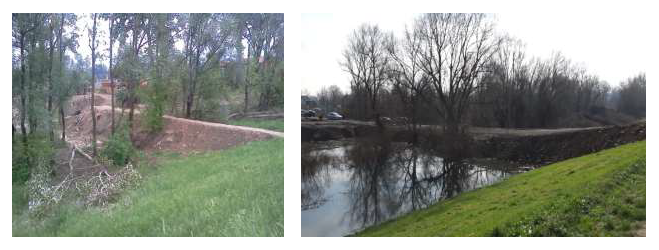
Some of these transverse levees (there are already a dozen of them), built to create access to illegally built holiday homes on water land (in the protection zone of the Belgrade Waterworks spring), direct high waters right to the levee in the most unfavorable way, which is out of question for river regulation and flood protection. It is incomprehensible that this activity took a very long time, and that the competent Public Water Management Company, in charge of the security of the flood protection system, did not prevent it and thus forced illegal builders to remove such dangerous objects.
It can be concluded that it would be absurd to receive funds for new coastal fortifications and coastal regulation in such circumstances when the incomparably more important protection system – the Sava levee – is security unreliable and violated by the previously described illegal activities:
- physical damage to the levee by excavation of trenches,
- traffic of heavy and other vehicles, except service vehicles and
- construction of transverse filled structures.
Due to the above, when acquiring a loan from the World Bank, the amount of the loan must include the costs of removing illegal facilities and repair costs on locations where any illegal activities have created unsafe conditions for the levee function. This request is completely justified, having in mind that the described abuses of the Sava levee make a bad impression about the organization of our society and respect for the basic legislation.
|
Working group of the Department of Civil Engineering Prof. Petar Anagnosti, PhD, B.C.E. Prof. Branislav Djordjevic, PhD, B.C.E. Prof. Miodrag Jovanovic, PhD, B.C.E. |
Secretary of the Department of Civil Engineering Prof. Dusan Najdanovic, PhD, B.C.E. President of the Academy of Engineering Sciences of Serbia (AESS) Prof. Branko Kovacevic, PhD, B.E.E. |
Prevod/Translation: Tijana Milišić

